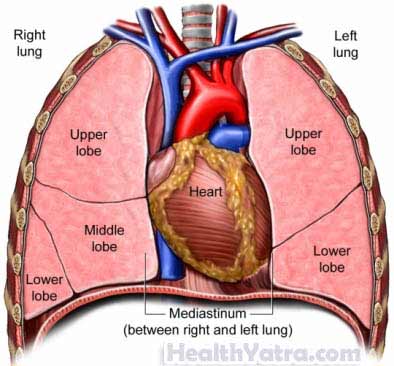Definition
The mediastinum is surrounded by the breastbone in front, the spine in back, and the lungs on each side. Mediastinal tumor resection removes tumors in this area of the chest cavity.

Reasons for Procedure
Cancerous tumors must be removed to prevent the spread of cancer. Without removal or treatment, the cancer could spread to other areas of the body. The cancer could also start to compress organs in the chest, such as the heart, lungs, esophagus, or spinal cord.
Patients who have this surgery often have a better prognosis than those who receive either radiation or chemotherapy.
Possible Complications
Complications are rare, but no procedure is completely free of risk. If you are planning to have mediastinal tumor resection, your doctor will review a list of possible complications, which may include:
- Damage to the areas surrounding the tumor, including the heart, lungs, and spinal cord
- Fluid collecting between the lung tissue lining and the wall of the chest cavity
- Drainage, infection, or bleeding
Factors that may increase the risk of complications include:
- Smoking
- Obesity
- Alcoholism
- Poor nutrition
What to Expect
Prior to Procedure
Before the surgery, your doctor may do the following:
- Physical exam
- Blood tests
- Take images of structures inside your body using x-ray, MRI scan, CT scan, or PET scan
Leading up to the surgery:
- Talk to your doctor about your medicines. You may be asked to stop taking some medicines up to one week before the procedure, like:
- Anti-inflammatory drugs such as aspirin
- Blood thinners
- Anti-platelet drugs
- Eat a light meal the night before the surgery. Do not eat or drink anything after midnight.
- Arrange for someone to drive you home from the hospital. Also, arrange for help at home.
Anesthesia
General anesthesia will be used. It will block any pain and keep you asleep through the surgery.
Description of the Procedure
You will have a breathing tube and be given an IV. The IV will be used to give you medicines and fluids during the surgery.
To remove the tumor, the doctor will make one large, central incision in the chest, an incision between the ribs, or several small incisions. If several small incisions are made, a camera will be inserted into one incision. The camera will allow the doctor to view the area via monitor. Through the other incisions, surgical tools will be inserted.
Tubes may be inserted into your chest. These tubes will help to drain fluid and air from the chest cavity. The incisions will be closed with staples or stitches.
Immediately After Procedure
The breathing tube will be removed. You will be monitored closely for any complications from the procedure.
How Long Will It Take?
About 1-4 hours depending on the type of surgery
How Much Will It Hurt?
The anesthesia will ease discomfort after surgery. It is common for the surgical area to be tender. Your doctor will give you pain medicine.
Average Hospital Stay
This surgery is done in a hospital setting. The usual length of stay is four days. Your doctor may choose to keep you longer if complications arise.
Post-procedure Care
After surgery, you may need chemotherapy and/or radiation therapy.
In the hospital, you will be given a clear liquid diet. You will be instructed to practice deep breathing and coughing to help your lungs recover.
When you are home, be sure to follow your doctor’s instructions, including:
- Avoid lifting objects heavier than five pounds.
- Do not to drive for 4-6 weeks.
- Increase your activity as you are able. This will help you recover.
Ask your doctor about when it is safe to shower, bathe, or soak in water.
Call Your Doctor
After you leave the hospital, contact your doctor if any of the following occurs:
- Signs of infection, including fever and chills
- Redness, swelling, increasing pain, excessive bleeding, or any discharge from the incision site
- Pain that you cannot control with the medicines you have been given
- Cough, difficulty breathing, or chest pain
- Pain, burning, urgency or frequency of urination, or blood in the urine
- Persistent nausea and/or vomiting
- Loss of appetite
- Pain and/or swelling in your feet, calves, or legs
- Any other worrisome symptoms
In case of an emergency, call for medical help right away.
